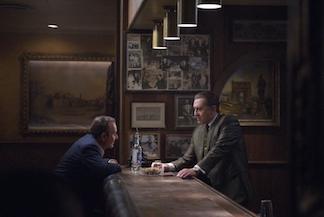|
|
Movie Review: The IrishmanBy Matthew HuntleyDecember 20, 2019
With its tried-and-true formula and archetypal characters in place, “The Irishman,” for much of its run, essentially goes through the motions of a typical Hollywood mob movie, showing us various mob family matters (weddings, holidays, baptisms) and the roles the family played in certain historical even. We see, for instance, how Hoffa reacted to the Kennedy assassination and that his being the target of Robert Kennedy eventually led to his conviction of jury tampering and a four-year stint in prison, where his rocky relationship with fellow Teamster Anthony “Tony Pro” Provenzano (Stephen Graham) became even rockier. Several notorious men from Bufalino and Hoffa’s inner circles also appear on-screen and we read subtitles detailing their history and cause of death, among other things, so the film does a commendable job of trying to be both entertaining and educational. But even though everything the film tells us is interesting and easy to grasp, I was hoping that by this point in his career, Scorsese would try a different strategy to expose us to this history and world. For its first two acts, there’s something about “The Irishman” that feels too clear-cut and straightforward. It doesn’t take many risks from neither a filmmaking nor narrative standpoint. It surprised me to think Scorsese would be okay with sticking to such a somewhat standard format because it’s one we’ve seen many times from movies of this type. Would Scorsese really just present things his usual way and that would be it? Luckily, that’s not it, because right around the halfway mark, my faith in the picture started to rise as it shifted from a mostly routine genre picture to a slow and quietly observant human drama that seeks to demystify and de-romanticize a life in the mob. If the first half makes Frank’s “adventures” seem like those found in a conventional Hollywood mob movie, the second is a solemn look at the way a life in organized crime can become a thankless and vicious cycle, one in which a “many-hats-wearing” guy like Frank is always beholden to someone in a higher position of authority and never able to fully relax. We begin to empathize with Frank as we get a better feel for just how downright frustrating his job can be, what with his having to drive a truck cross-country, hop on a plane, deliver a package, kill a man, etc., all at a moment’s notice and all without asking questions. When Zaillian’s screenplay becomes more screen direction than dialogue and we simply watch Frank carry out the orders of his boss in long, uninterrupted stretches, we really absorb the film and its themes more. Even though Scorsese’s precise eye, combined with director of photography Rodrigo Prieto’s vibrant imagery and Bob Shaw’s production design are felt throughout, it’s when the film slows down that we notice all of them on a deeper level and they become more penetrating. It’s also at this point we’re reminded of Robert De Niro’s raw talent as an actor because for much of the latter half of the film he has to perform without the aid of dialogue and rely on his own body gestures, facial features and internal thoughts to convey Frank’s dilemma and irritation. It also dawns on us that, in many ways, De Niro has been playing against type this whole time. We’re so used to seeing him as the man in charge and a hard-knuckled tough guy, and even though he portrays Sheeran as merciless at times, here we see him credibly nervous, hesitant and beating around the bush with Russell and Hoffa in order to appease them, and the anxiety Frank feels allows us to view him as human and vulnerable. We listen to his narration more intently as the film goes on and we come to care about this remorseful and lonely individual, even though is behavior is reprehensible. “The Irishman,” whether true or not (there have been various articles discrediting Sheeran’s accounts of the facts), is always well made, and on the whole, it ranges from good to very good, but I hesitate to call it great because it takes too long to break away from its initially traditional formula and establish its own identity, eventually showing us an aspect of organized crime we might not have considered or experienced before. Even if isn’t up to masterpiece level, the directing, acting and production values are strong and watchable enough that there’s never anything outright bad to say about the movie, which is remarkable given its runtime. But should Scorsese and company ever unite again in their lifetimes, I hope they consider progressing their own standards and pushing viewers outside their comfort zones earlier on.
|

|
|
|

|
Thursday, October 31, 2024
© 2024 Box Office Prophets, a division of One Of Us, Inc.


